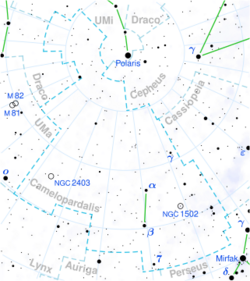Astronomy:HD 24479
| Observation data Epoch J2000.0 Equinox (celestial coordinates) | |
|---|---|
| Constellation | Camelopardalis |
| Right ascension | 03h 57m 25.44460s[1] |
| Declination | +63° 04′ 20.1498″[1] |
| Apparent magnitude (V) | 5.04[2] |
| Characteristics | |
| Evolutionary stage | main sequence[3] |
| Spectral type | B9 IV[4] or B9.5 V[5] |
| U−B color index | −0.16[2] |
| B−V color index | −0.10[2] |
| Astrometry | |
| Radial velocity (Rv) | 4.6±2.8[6] km/s |
| Proper motion (μ) | RA: +7.146[1] mas/yr Dec.: +6.420[1] mas/yr |
| Parallax (π) | 8.4614 ± 0.0947[1] mas |
| Distance | 385 ± 4 ly (118 ± 1 pc) |
| Absolute magnitude (MV) | −0.27[7] |
| Details | |
| Mass | 3.14±0.05[3] M☉ |
| Radius | 4.08±0.20[8] R☉ |
| Luminosity | 156+12−11[3] L☉ |
| Surface gravity (log g) | 3.69±0.06[9] cgs |
| Temperature | 10,520+72−73[3] K |
| Metallicity [Fe/H] | −0.20[10] dex |
| Rotational velocity (v sin i) | 85±16[11] km/s |
| Age | 256±20[12] Myr |
| Other designations | |
| Database references | |
| SIMBAD | data |
HD 24479, also designated as HR 1204, is a solitary,[15] bluish-white hued star located in the northern circumpolar constellation Camelopardalis. The star is visible to the naked eye with an apparent visual magnitude of 5.04.[2] Based on Gaia DR3 parallax measurements,[1] it is located 385 light years from the Sun. However, it is receding with a somewhat constrained heliocentric radial velocity of 4.6 km/s.[6] At its current distance, HD 24479's brightness is diminished by 0.29 magnitudes due to interstellar dust.[16]
In 1932, HD 24479 was identified as a Be star by Olin C. Wilson at the Mount Wilson Observatory.[17] In 1969, astronomer Anne Cowley and her colleauges listed a stellar classification of B9.5 V,[5] matching a B-type main-sequence star. Slettebak (1982) gave it a class of B9 IV,[4] suggesting this instead an evolving subgiant star. Zorec and Royer (2012) model it to be an evolved dwarf star that has completed 85.9% of its main sequence lifetime.[3]
It has an estimated 3.14 times the mass of the Sun[3] and 4.1 times the Sun's radius,[8] which is large for its class. The star is radiating 156 times the Sun's luminosity[8] from its photosphere at an effective temperature of 10,250 K.[3] HD 24479 is estimated to be 256 million years old[12] and is spinning quickly with a projected rotational velocity of 85 km/s.[11]
References
- ↑ 1.0 1.1 1.2 1.3 1.4 1.5 Vallenari, A. et al. (2022). "Gaia Data Release 3. Summary of the content and survey properties". Astronomy & Astrophysics. doi:10.1051/0004-6361/202243940 Gaia DR3 record for this source at VizieR.
- ↑ 2.0 2.1 2.2 2.3 Ducati, J. R. (2002). "VizieR Online Data Catalog: Catalogue of Stellar Photometry in Johnson's 11-color system.". VizieR Online Data Catalog. Bibcode: 2002yCat.2237....0D.
- ↑ 3.0 3.1 3.2 3.3 3.4 3.5 3.6 Zorec, J.; Royer, F. (January 2012). "Rotational velocities of A-type stars IV: Evolution of rotational velocities". Astronomy & Astrophysics 537: A120. doi:10.1051/0004-6361/201117691. ISSN 0004-6361. Bibcode: 2012A&A...537A.120Z.
- ↑ 4.0 4.1 Slettebak, A. (September 1982). "Spectral types and rotational velocities of the brighter Be stars and A-F type shell stars". The Astrophysical Journal Supplement Series 50: 55. doi:10.1086/190820. ISSN 0067-0049. Bibcode: 1982ApJS...50...55S.
- ↑ 5.0 5.1 Cowley, A.; Cowley, C.; Jaschek, M.; Jaschek, C. (April 1969). "A study of the bright stars. I. A catalogue of spectral classifications.". The Astronomical Journal 74: 375. doi:10.1086/110819. ISSN 0004-6256. Bibcode: 1969AJ.....74..375C.
- ↑ 6.0 6.1 Gontcharov, G. A. (November 2006). "Pulkovo Compilation of Radial Velocities for 35 495 Hipparcos stars in a common system". Astronomy Letters 32 (11): 759–771. doi:10.1134/S1063773706110065. ISSN 1063-7737. Bibcode: 2006AstL...32..759G.
- ↑ Anderson, E.; Francis, Ch. (May 2012). "XHIP: An extended hipparcos compilation". Astronomy Letters 38 (5): 331–346. doi:10.1134/S1063773712050015. ISSN 1063-7737. Bibcode: 2012AstL...38..331A.
- ↑ 8.0 8.1 8.2 Kervella, P.; Thévenin, F.; Di Folco, E.; Ségransan, D. (October 2004). "The angular sizes of dwarf stars and subgiants". Astronomy & Astrophysics 426 (1): 297–307. doi:10.1051/0004-6361:20035930. ISSN 0004-6361. Bibcode: 2004A&A...426..297K.
- ↑ Stassun, Keivan G. et al. (9 September 2019). "The Revised TESS Input Catalog and Candidate Target List". The Astronomical Journal 158 (4): 138. doi:10.3847/1538-3881/ab3467. Bibcode: 2019AJ....158..138S.
- ↑ Anders, F. et al. (August 2019). "Photo-astrometric distances, extinctions, and astrophysical parameters for Gaia DR2 stars brighter than G = 18". Astronomy & Astrophysics 628: A94. doi:10.1051/0004-6361/201935765. ISSN 0004-6361. Bibcode: 2019A&A...628A..94A.
- ↑ 11.0 11.1 Abt, Helmut A.; Levato, Hugo; Grosso, Monica (July 2002). "Rotational Velocities of B Stars". The Astrophysical Journal 573 (1): 359–365. doi:10.1086/340590. ISSN 0004-637X. Bibcode: 1982ApJS...50...55S.
- ↑ 12.0 12.1 Gontcharov, G. A. (November 2012). "Spatial distribution and kinematics of OB stars". Astronomy Letters 38 (11): 694–706. doi:10.1134/S1063773712110035. ISSN 1063-7737. Bibcode: 2012AstL...38..694G.
- ↑ Verbunt, F.; van Gent, R. H. (June 2010). "The star catalogue of Hevelius". Astronomy and Astrophysics 516: A29. doi:10.1051/0004-6361/201014003. ISSN 0004-6361. Bibcode: 2010A&A...516A..29V.
- ↑ "HD 24479". SIMBAD. Centre de données astronomiques de Strasbourg. http://simbad.u-strasbg.fr/simbad/sim-basic?Ident=HD+24479.
- ↑ Eggleton, P. P.; Tokovinin, A. A. (11 September 2008). "A catalogue of multiplicity among bright stellar systems". Monthly Notices of the Royal Astronomical Society 389 (2): 869–879. doi:10.1111/j.1365-2966.2008.13596.x. ISSN 0035-8711. Bibcode: 2008MNRAS.389..869E.
- ↑ Gontcharov, George A.; Mosenkov, Aleksandr V. (28 September 2017). "Verifying reddening and extinction for Gaia DR1 TGAS main sequence stars". Monthly Notices of the Royal Astronomical Society 472 (4): 3805–3820. doi:10.1093/mnras/stx2219. ISSN 0035-8711. Bibcode: 2017MNRAS.472.3805G.
- ↑ Wilson, Olin C., Jr. (April 1932). "Three New Be Stars". Publications of the Astronomical Society of the Pacific 44 (258): 124. doi:10.1086/124211. ISSN 0004-6280. Bibcode: 1932PASP...44..124W.
External links
- http://www.alcyone.de/cgi-bin/search.pl?object=HR1204
- http://server3.wikisky.org/starview?object_type=1&object_id=1873
 |


